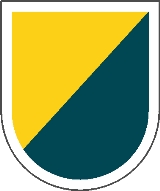
8th Special Forces Group
Encyclopedia
The 8th Special Forces Group of the United States Army
was established in 1963 at Fort Gulick
, Panama Canal Zone
. The primary mission of the 8th SFG was counter-insurgency training for the armies of Latin America. Some training was performed under the sponsorship of the School of the Americas, also located at Fort Gulick.
Special Forces at this time didn't use designators like "battalion". A Special Forces company (which later became a battalion) was commanded by a Lt. Colonel and was designated as a "C" team. The 8th had 2 "C" teams. Each "C" team had 3 "B" teams and each "B" team had 5 "A" teams. The 8th SAF also operated the NCO Academy, Airborne School and Underwater Operations School for the US Army Southern Command (USARSO) and provided support for the Jungle Warfare School at Fort Sherman, later renamed the Jungle Operations Training Center to be politically correct.
, Panama, and conducted the first HALO school outside of Ft. Bragg, North Carolina, at Fort Kobbe
and Howard Air Force base, Canal Zone, in 1970. The HALO team also had a good-will mission as the "Jumping Ambassadors" and conducted exhibition parachute jumps at carnivals, festivals and other public events throughout Latin America.
in the fall of 1967.
Prior to that time, Mobile Training Teams from the 8th Special Forces Group trained counter-insurgent units in Venezuela, Colombia and Ecuador that killed three of Che Guevara's best friends and Lieutenants that he had personally dispatched to those three nations to foment revolutions.
Mobile training teams from the 8th Special Forces Group also assisted the Venezuelan Army in the construction of their jump school. They trained the first students and the cadre for following classes.
At the U.S. Army Airborne School at Ft Sherman in the U.S. Canal Zone, a team of the 8th Special Forces Group trained Guatemalan airborne personnel.
United States Army
The United States Army is the main branch of the United States Armed Forces responsible for land-based military operations. It is the largest and oldest established branch of the U.S. military, and is one of seven U.S. uniformed services...
was established in 1963 at Fort Gulick
Fort Gulick
Fort Gulick was a U.S. Army base in the former Panama Canal Zone located on the Atlantic side of the Panama Canal near Fort Davis, on Gatun Lake.-History:It was perhaps best known as the location of the School of the Americas...
, Panama Canal Zone
Panama Canal Zone
The Panama Canal Zone was a unorganized U.S. territory located within the Republic of Panama, consisting of the Panama Canal and an area generally extending 5 miles on each side of the centerline, but excluding Panama City and Colón, which otherwise would have been partly within the limits of...
. The primary mission of the 8th SFG was counter-insurgency training for the armies of Latin America. Some training was performed under the sponsorship of the School of the Americas, also located at Fort Gulick.
Organization
The 8th's full designation was 8TH Special Forces Group (Abn), Special Action Force, Latin America. The 8th was the US Army's only full SAF. In addition to the two line Special Forces companies, the SAF included a Military Intelligence detachment, a Medical detachment, a Military Police detachment, an Engineer detachment, an Army Security Agency detachment, and a Psychological Operations battalion.Special Forces at this time didn't use designators like "battalion". A Special Forces company (which later became a battalion) was commanded by a Lt. Colonel and was designated as a "C" team. The 8th had 2 "C" teams. Each "C" team had 3 "B" teams and each "B" team had 5 "A" teams. The 8th SAF also operated the NCO Academy, Airborne School and Underwater Operations School for the US Army Southern Command (USARSO) and provided support for the Jungle Warfare School at Fort Sherman, later renamed the Jungle Operations Training Center to be politically correct.
Subordinate units
Company A of the 8th Group was tasked with developing and maintaining a High Altitude Low Opening (HALO) team, Detachment A-13, that was prepared to make covert free-fall entry to denied airspace by jumping from altitudes in excess of 30,000 feet. The team trained at the abandoned airstrip at Rio HatoRío Hato
Río Hato is a town in the Coclé province of Panama.- Sources :* – World-Gazetteer.com...
, Panama, and conducted the first HALO school outside of Ft. Bragg, North Carolina, at Fort Kobbe
Fort Kobbe
Fort Kobbe was an Army fort created in 1932 that was adjacent to Howard Air Force Base in Panama. It was a relatively small post, and housed a battalion of paratroopers , a firing battery of artillery M-102 105mm; six gun battery with survey and search light section, a battalion of engineers , and a...
and Howard Air Force base, Canal Zone, in 1970. The HALO team also had a good-will mission as the "Jumping Ambassadors" and conducted exhibition parachute jumps at carnivals, festivals and other public events throughout Latin America.
Notable operations
A Mobile Training Team from the 8th Special Forces Group trained and advised the Bolivian Ranger Battalion that captured and killed Che GuevaraChe Guevara
Ernesto "Che" Guevara , commonly known as el Che or simply Che, was an Argentine Marxist revolutionary, physician, author, intellectual, guerrilla leader, diplomat and military theorist...
in the fall of 1967.
Prior to that time, Mobile Training Teams from the 8th Special Forces Group trained counter-insurgent units in Venezuela, Colombia and Ecuador that killed three of Che Guevara's best friends and Lieutenants that he had personally dispatched to those three nations to foment revolutions.
Mobile training teams from the 8th Special Forces Group also assisted the Venezuelan Army in the construction of their jump school. They trained the first students and the cadre for following classes.
At the U.S. Army Airborne School at Ft Sherman in the U.S. Canal Zone, a team of the 8th Special Forces Group trained Guatemalan airborne personnel.

